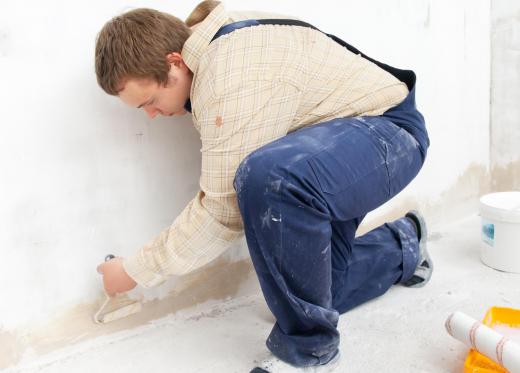Hanging Sheetrock® on a ceiling has always been a tough job because of the size and weight of the Sheetrock® panels. A Sheetrock® lift, or drywall lift, can make this job both easier and safer. It performs all of the heavy lifting involved in hanging Sheetrock® by raising the drywall panels into place and holding them there until they are safely fastened. It allows one person to safely hang Sheetrock®, rather than requiring a crew of two or three people to do the job.
A Sheetrock® lift typically has a wheeled base that allows it to be easily moved around a room. A lifting mechanism is mounted on the base to facilitate raising and lowering the Sheetrock® lift, and an upper section with support arms holds the Sheetrock® while it is being lifted. With the help of the lift, all the installer has to do is concentrate on fastening the positioned drywall into place.

Hanging Sheetrock® on ceilings typically requires several hands. That is because Sheetrock®, also called drywall or gypsum board, is available in several thicknesses and dimensions, all of them rather large. While common thicknesses range from 1/4 inch (6.35 mm) up to 5/8 inch (15.8 mm), common dimensions are 4 feet (1.2 m) by 8 feet (2.4 m) and 4 feet (1.2 m) by 12 feet (3.6 m). The larger sheets can weigh more than 100 pounds (45 kg) each. The weight of the Sheetrock® and the need to handle it carefully to avoid breaking the board typically make it difficult to install Sheetrock® on a ceiling without help.
Sheetrock® lifts have historically been a rather expensive investment, but they have become increasingly affordable. This price decrease has spurred interest in purchasing Sheetrock® lifts even among people who only use them occasionally. Many rental stores also rent Sheetrock® lifts on a daily or weekly basis. This can be an affordable option for someone who needs to hang Sheetrock® on a ceiling or high wall but does not anticipate needing a lift often enough to justify purchasing one. Many lifts also are designed to break down into several pieces for easy transport and may even fit in a passenger car.
Some contractors still prefer to hang Sheetrock® without the use of a lift. Despite the convenience these lifts provide to solo drywall hangers, using a lift may not be as fast as having an experienced crew lift the Sheetrock® panels into position. The key advantage of using a Sheetrock® lift is that one person can safely install Sheetrock® on a ceiling. Using a machine to perform the repetitive, heavy lifting may also reduce the risk of injury.
